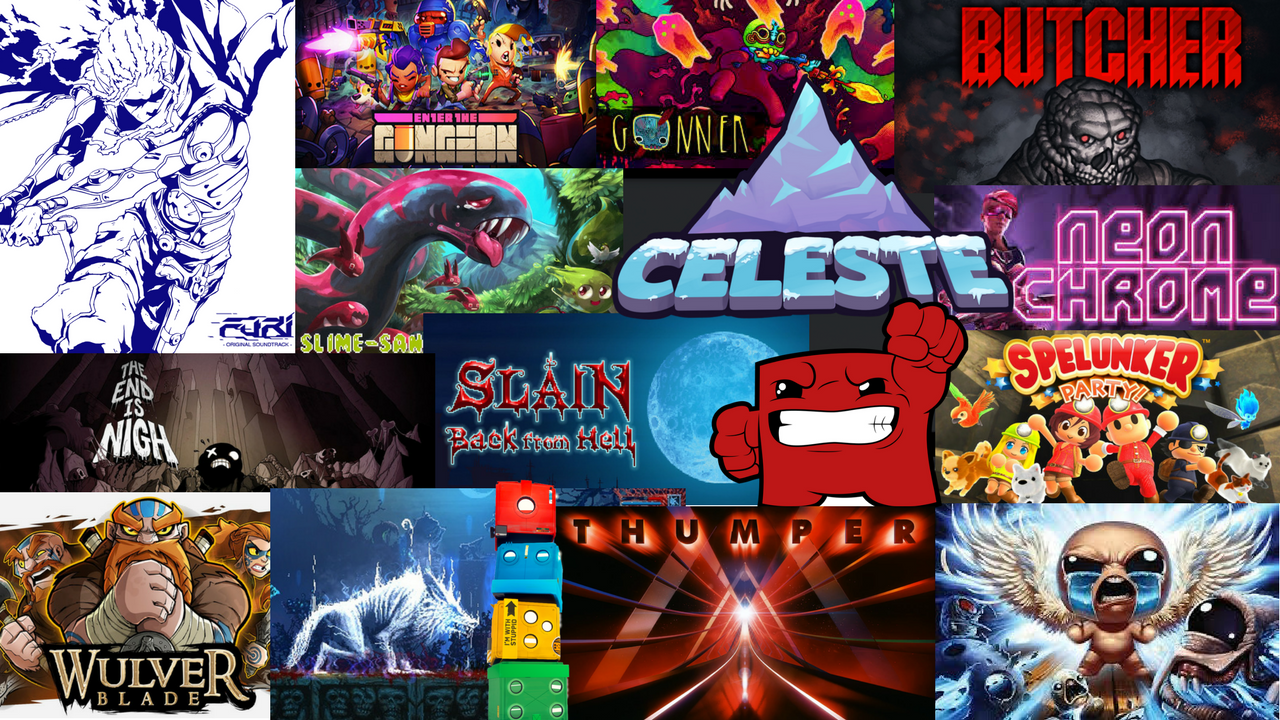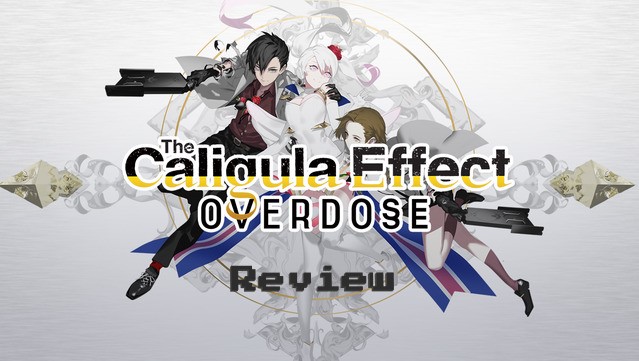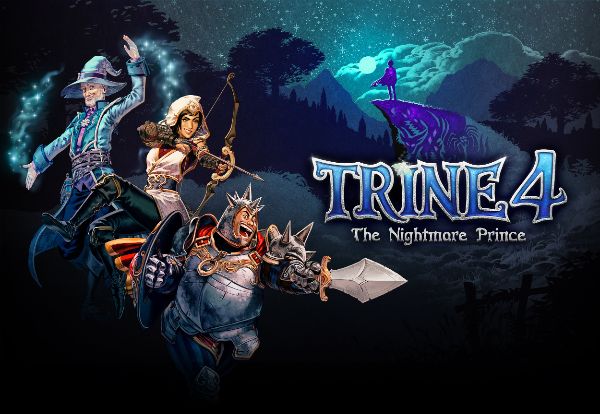The Caligula Effect: Overdose Switch Review by SwitchWatch
Developer: FURYU Corporation
Publisher: NIS America
Download Size 5.2 Gb
Release Date: 5th March 2019
Price as of Article: $49.99 USD, £44.99 GBP
Game code provided by NIS America
Within The Caligula Effect: Overdose Switch Review, I am going to try and keep it as spoiler-free as possible and talk about the intro and touch on a few points within the game.
The Start
The story of The Caligula Effect: Overdose begins with the player picking the gender and the name of the main character. The game starts at a new year at Kishimai High School, with the head of each school year addressing the new school starters. Where your character (from now on, I will refer to the main character as Fuki, my main) notices that something is wrong with some of the school members. Some of the pupils’ faces start to flicker and change, and then run out the school. It is when she has ‘graduated’ from school, at least, that’s what some pupils say.

Running out of school, scared from what she had seen, Fuki ends up in the middle of the city, where there is a music concert being held. Here you meet µ (Mu), the singer, who flies over to you and asks if you are having fun here in Mobius. After a short talk, Mu is asked by Aria to go the Metaverse-E. Once Mu is away, the fans of Mu try to hunt Fuki down for making her leave. Again, Fuki runs for her life with Aria, where she meets Shogo Satake, well, gets headbutted by him. He tells Fuki it is not safe now, that they are after her, and that they must get back to the school. Here is the first fight, as well as the reason Aria is here; it is to release what is in the heart so that they can fight.
After getting back to school, you are invited to join the Go-Home Club. A place where people, like Fuki, know the truth about Mobius and want to get home to the real world. Aria explains that she and Mu created this world and that as Mu got more popular, Aria got smaller, losing her power to change the world. Also, along with this, it turns out that the real people in the world are all in here to be happy as they have had some major traumatic event happen to them.
After some more explanation of the world and things that have happened, Fuki is made the president of the Go-Home Club and is tasked with getting the members of the Go-Home Club home. Aria suggests taking down the Musicians that keep the people of Mobius inline and under control, and ask them where Mu is.
If only it were that simple. Leading Fuki and the Go-Home Club on an adventure that spans the whole City of Mobius to find Mu and to get them back home. Meet an expansive cast of characters that will join you in the hunt, each being quirky and interesting. You get to see the conflict from both sides – the Go-Home Club and the Musicians – while helping as many students as possible with their trauma, to get home and decide the fate of Mobius.
My Thoughts
For myself, playing The Caligula Effect: Overdose while knowing very little about the story or the characters, I found myself lost in this world from the get-go. The story is paced well, the character interactions make you feel invested in them, and that each one is hiding something deep within themselves that they have to overcome. The story is amazing! I loved every moment, even the bizarre stuff.
Firstly
As this is a re-release of a PS Vita game, there have been a few changes made for the Overdose edition. There have been four new characters added to the game that are fully integrated into the story. The story and interactions with characters will change if you pick a female protagonist, allowing for more storylines to branch out, as well as letting Fuki be a musician and taking on the Go-Home-Club, while an entirely new storyline unfolds.
The Imaginary Chain Battle System Overview
Let’s begin with what effectively makes up around 80% of the game, The Caligula Effect’s take on the turn-based battle system.
The battle flow is: Skill selection, Imaginary Chain, and enactment. To begin enactment, you can press A to link another ability or press X to begin the enactment. Skill is broken down into three categories: Attack (deal damage), Support (buffs and heals), and Action (defend, soul surge – regain soul points). Each ability uses soul points – once out of soul points, you cannot act until you use soul surge and replenish them.
If all the party members health gets reduced to 0, it is game over. After each fight, the parties health and SP are restored.
What is the Imaginary Chain? This is the game version of the active time battle, ATB in short; it allows the player to assign up to three abilities at one time and will show when the characters attack, as well as when the enemy will attack. This picture will outline the Imaginary Chain:

As you can see, there is a lot of things happening in the battle. The Imaginary Chain allows the player a glimpse into the future to show what actions are about to be performed are possibly going to do (it may not go that way). It also shows what ability the enemy is going to use — allowing for a more tactical view towards the battle, as attacks can be planned on what the enemy will be doing as well as what attacks to follow up with.
The chain ability highlighted in the picture (by the green arrow), is the ability the Imaginary Chain will show the possible outcome for. The other chain abilities that are on the Chain are locked in and will activate once the red marker makes it to the left side of the chain. There is also a red line that goes in the opposite direction that highlights when enemies are going to attack once it hits the break like in the chain (highlighted by the yellow arrows). That covers the basics.
The More Advanced Chain Links And Breaks
The Chain Links are the ability to chain three attacks together for each character, this, in turn, lowers the time between each action. More so, the Chain links can be combined between part members for some Linked devastating attacks. The Imaginary Chain does not only allow a glimpse of the future, it also allows for the slight manipulation of the timings of each attack. Each chain ability has a set bar that can be used to move the timing of an attack to better correspond with another attack.
Example: Fuki has an attack called Shadow Pierce; this will send an enemy in the air when it breaks a shield (defend). Shogo Satake has an attack called Gunslinger; this will attack enemies in the air to do extra damage. If on the imaginary Chain these too attacks where too far apart to make a chain link, then it may be possible to move each attack closer together by chaining the timings, by pressing left or right on the arrow keys when that ability is highlighted. Abilities from all party members can be combined to make majorly damaging Chain Links. Learning the best attacks for this is key to winning most of the latter fights.
Next, to each enemy, there will be a number from 0-5, this is the risk number. Once it hits five, the enemy will break allowing for all attacks to be critical attacks as well as allowing for more powerful attacks to be used when risk is at a certain level. There are three ways to increase risk (only in a dungeon):
1. Sucker punch hitting the enemy without being seen out of battle
2. Multiple hits will slowly raise the bar to increase the risk
3. Some abilities will instantly increase risk by one, if successful
I recommend mastering this aspect of the battle system to try and take advantage of it as much as possible.
Catharsis Effect and Digiheads
Within dungeons, it is vital that Aria is with you; she has the power to make let Fuki and her companions fight without being corrupted and being turned into a Digihead. Aria’s power only works on people who know Mobius is not real and want to go home for whatever reason they have. Digiheads are pupils that have been controlled by the Musician and are trying to stop anyone from getting home from Mobius. Why? You will need to find that out for yourself.
Weapons and Rolls

Fuki – Dual Wielding – Jack of all trades, excels at nothing.
Shogo – Revolver – High damage to launched and downed enemies
Kotono – Bow and Arrow – Support
Kotaro – Gauntlets – Massive damage up close
Kensuke – Broad Sword – Defense and Counterattacks
Mifue – Hammer – Increase risk, increased damage
Ayana – Shield – Stuns and debuffs
Suzuna – Spear – Versatile fighter can do most things, with the tradeoff being low HP and defense
Naruko – Lasers – disrupting attacks
There are a couple more weapons, but these are the core members who you will meet or gain early on.
Levelling Up and Skill levelling
As in all JRPGs, there will be experience points allocated (EXP), and once Fuki and the other have hit the necessary EXP threshold, they will level up, and the statistics will improve slightly. The four characters in the main party will get 100% of the EXP awarded while the characters in reserve will only get 50% EXP given each fight. This is a staple of almost all JRPGs.
As well as leveling up, there will be 3 skill points given for everyone who levels up, each attacking skill has three levels that cost a set amount of skill points to unlock. Witch each level, the skill will gets stronger, as well as being more effective towards higher level enemies. While leveling up, new skills will be unlocked; skill points are used to make them useable as well.
There are a few ways in which to gain skill points: level up, defeating bosses, finding enigmas and discarding Stigma.
Stigmas And Passive
Within Mobius, there is no money that Fuki can obtain to get new equipment. In this case, there is Stigma. There are two ways to acquire new Stigma: defeating enemies and getting them as a reward, or finding and getting them from Soul Remnants – these are chests in the worlds. Equipping Stigma increases statistics of each character. They build up quickly, so customising each character to fit the preferred playstyle is rapidly achieved.
Stigma comes in three categories;
Attack Impulse – Improves damage and accuracy
Defence Instinct – Defence and HP (Hit Points)
Amplification – enhances SP and Critical Strikes
There also passive bonuses that will be equipped to make each character even stronger or more useful in there preferred fighting style.
Causality Links, Trauma Quest and WIRE

The Causality Links is a system in place where it shows every person within Mobius and how they all relate to each other. It is split into classes, from Year 1 Class 1, to Year 4 Class 4. There are 524 different people to link. This will seem daunting at first, it did for me, but the system is rather simple once you understand it, but it can be rather tedious also.
As you make your way through the game, Fuki will come across other students that are in Mobius. Next to each of the names (yes, all 524 people have their own name, would have hated to have that job) will be a yellow triangle with a number next to it or a lock. The triangle shows the Causality Link 0 – Star. To increase the Link, you have to talk to that character three times, it will rise to level 3. To unlock the Star, you will need to partake in the students Trauma Quest, once you raise the Link to level 3, you will unlock the traumatic event that leads them to be in Mobius and how to heal their heart. If you complete the quest, then you will get a passive skill, as well as unlock the person next to them in the Causality Link if they are locked. Not only does the now befriended character give you the passive ability, they can also join the party to fight for you. This is necessary for some Trauma Quests.
The WIRE is the in-game social media chatting app. Everyone you meet and talk to will gets added to the WIRE, where you can send them messages if you like. It is also used by the Go-Home-Club for character interactions throughout the game, as well as used for relaying important in-game events or cutscenes. Fuki can send messages to get to know the members of the Go-Home-Club, as well as used for the in-game help if you are stuck with what to do next. There will be conversations displayed on the screen of the members discussing events that have just occurred or talking to new members.
Companion Quest and Personalities
Unlike the pupils that you talk to within the school, the members of the Go-Home Club and the musicians Causlatiy Link go from 3 to 9 then Star. The way to increase these is through battles with the members – Fuki needs to improve relationships with. This all goes to completing Companion Quests. Companion Quests comprise of 10 small cutscenes in which you have to help a group member fix their hearts. Throughout the Quest, Fuki will be asked to decide on how to best support the member. It is possible to cancel the quest by upsetting a member you want to help.

Once a companion Quest is complete, the characters personality will change. Personality is a set of statistics that each member has in what they are good at. It’s a graph that shows the overview of the statistics
For me, this was amazing, I am a massive lore geek and love to find out more about each character, as well as there are some heartwarming and funny moments. It massively helped to flesh out the characters even more than just what I found out about them during the story.
Map

There are two maps, one is the dungeon map that fills out as Fuki and her friends traverse these. It shows enemy placement as well as soul remnant and stairs. I found it quicker to get around the dungeons with the map up fully on screen.
The other is the City map which shows all the places Fuki have visited as well as any she has not. It will also highlight the main mission and anything else of importance.
Records of Mobius

The records of Mobius keep a record of any Enigmas found. Enigmas are glimpses into the real world and the loss there.
Along with Enigmas, there are Word Rewards. These words are formed from other people in Mobius trying to get home and have failed to leave behind there souls; these are the soul remnants.
The words from these lost souls are, dropped by enemies. These are used to unlock rooms. What are in these rooms? I’ll let you find out.
style=”display:block; text-align:center;”
data-ad-layout=”in-article”
data-ad-format=”fluid”
data-ad-client=”ca-pub-5661714653949151″
data-ad-slot=”5669732186″>
(adsbygoogle = window.adsbygoogle || []).push({});
As The Caligula Effect: Overdose has a lot to do with music, you would expect the soundtrack to be of very high quality. Well, it does not disappoint. From the upbeat J-Pop styled tracks, heavy rock tracks, to the deeper more darker tracks of the boss fights, each has been crafted exceptionally. There is, for me, not a single weak track in the game from Sadistic Queen and Peter Pan Syndrom.
The game is all voiced in Japanese, with voice talents such as:
Rena Ueda (Mu) – Tokyo Ghoul, ReLIFE, and Super Smash Bro. Ultimate
Rie Takahashi (Mihue Shinohara) – Fate/Grand Order, Fire Emblem Heros, Sushi Striker (Female)
Yuichiro Umehara (Izuro Minesawa) – Fire Emblem Heros, Octopath Traveler, Kingdom Hearts III
These are only some of the talented voice actors they have within the cast; all the Japanese Voices are excellent.
The sound effects are of good quality too. Not on par with the voice acting or music, but you can tell when a gun is shot or the distinctive sounds of each attack.
Visuals are a bit of a mixed bag for The Caligula Effect: Overdose. The game uses the Unreal 4 Engine, so I for one was excited to see how well this was going to look, especially after the trailers, I was damn excited. Then I started the game, OK, so they are not all bad but, some textures are very poorly done. For instance, in the library all the books on the shelves are the same and are not all that polished and grainy. In one cutscene, Fuki was up to her knees in the middle of the street while the other two characters are on the street. This is in no way a dig at the developers in Furyu; it is more pointing out the limitations of the Switch. With the fact that a lot of technical problems can be fixed in patches. So some of the textures will not be as polished as some of the other console, but they still look good for the size and scope of the game.

Even if some textures are not detailed, it does not mean that the game itself is not beautiful. Some of the backdrops are in a word, stunning, with some of the best water effects I have seen on the Switch to date. Then you get some fantastic things like the battle arena, like a lot of JRPGs, is a circle that contains the fight. Here, if the circle intersects a wall or an object, it will cut it away and show you the other side. First time I saw that I stopped fighting and took a moment to realise what was going on. With almost all the locations Fuki and the others will visit, there is a starting area that is hand-drawn, and they are stunning. Not to mention some cutscenes are fully animated.
For the performance, generally, the game runs fine. There were a few incidences of momentary slow down when there are lots of attacks happening, and new enemies join the fight all at the same time. It only happened a handful of times in my playthrough, so really not a problem.
Handheld play and docked both run smooth, but the increased resolution of the docked mode is the way to play this one.
The Caligula Effect: Overdose comes in at $49.99 USD, £44.99 GBP. This is pretty much standard pricing for a game of this calibre. I would have no problems forking out the £44.99. The amount of content and story is well worth the price tag.
If you want more of NIS America’s excellent games, then check out my review of The Lier Princess and The Blind Prince.
Pros
Deep, fleshed out characters
A crazy, insightful, dark story
Outstanding Soundtrack and voice acting
Brilliant battle system
Plenty of content
Cons
Few technical difficulties
Can be a bit overwhelming









